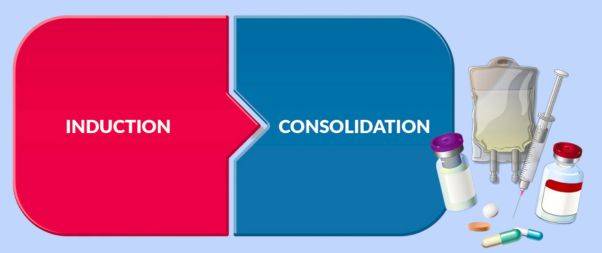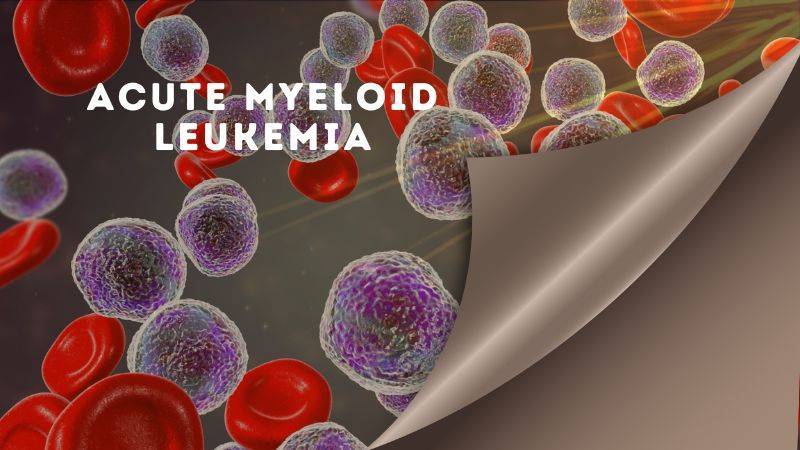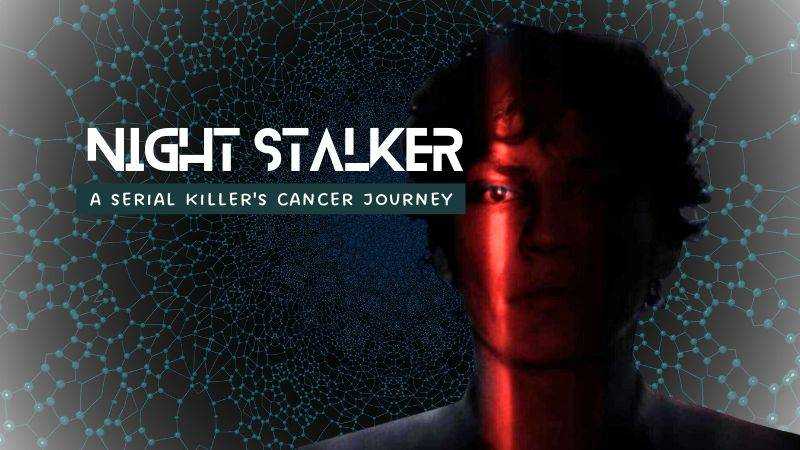Acute Myeloid Leukemia (AML) is a cancer type that affects the blood and bone marrow, resulting in rapid growth of abnormal white blood cells.
These cells fail to function properly and interfere with the production of normal blood cells.
Let’s learn more about AML:
What is Acute Myeloid Leukemia?

Leukemia is a disease that affects the white blood cells, making it a type of cancer. When it’s “acute,” it means the disease progresses rapidly and needs to be treated right away.
It is the most common acute leukemia in adults, though it can occur in people of all ages.
This cancer type starts in the bone marrow, the soft inner part of certain bones where new blood cells are made.
Acute leukemia can be categorized based on the kind of white blood cells it involves.
The two primary kinds of white blood cells are:
- Monocytes and granulocytes, which originate from myeloid stem cells.
- Lymphocytes, which come from lymphoid stem cells.
AML is a fast-acting cancer that affects the monocytes or granulocytes.
Causes and Risk Factors
 The exact cause of AML is not known. However, several risk factors may increase an individual’s likelihood of developing this disease. They include:
The exact cause of AML is not known. However, several risk factors may increase an individual’s likelihood of developing this disease. They include:
- Age: AML is more common in older adults.
- Gender: Men are more likely to develop AML than women.
- Previous cancer treatment: People who have undergone certain types of chemotherapy or radiation therapy for other cancers are at a heightened risk.
- Exposure to certain chemicals: Long-term exposure to chemicals like benzene, used in the rubber industry, can raise the risk.
- Genetic disorders: Certain genetic disorders, like Down syndrome, increase the risk of AML.
- Smoking: Tobacco use is a known risk factor for AML.
Symptoms
AML can cause a variety of symptoms, which may differ from person to person. Common signs and symptoms include:
- Fever
- Fatigue and weakness
- Shortness of breath
- Pale skin
- Frequent infections
- Unexplained weight loss
- Bleeding or bruising easily
- Bone pain
- Swollen gums
These symptoms can also be caused by conditions other than AML. If you experience any of these symptoms, it is important to seek medical attention.
Diagnosis

During the early stages of diagnosing acute myeloid leukemia (AML), your primary doctor will examine you for physical signs of the disease and order blood tests for you.
If the test reveals an unusually high number of abnormal white blood cells, or a very low blood count, it might be a sign of leukemia.
If that’s the case, you’ll be promptly referred to a blood disease specialist, also known as a hematologist.
This specialist may conduct additional tests.
Bone Marrow Biopsy
To confirm an AML diagnosis, the doctor will take a small sample of your bone marrow to examine under a microscope. This is called a bone marrow biopsy.
During this procedure, the doctor or nurse will numb an area on the back of your hip bone, then use a thin needle to extract some liquid bone marrow.
In some instances, they’ll remove both liquid bone marrow and a small piece of bone marrow together.
The procedure shouldn’t hurt, but you might feel a little uncomfortable when the sample is taken.
You might also experience bruising and slight discomfort for a few days after.
The procedure usually lasts 20 to 30 minutes.
The doctor will then check the bone marrow sample for cancer cells. If they find any, the biopsy can also help determine the type of leukemia you have.
Additional Tests
More tests can provide further information about the status and extent of your AML and can also guide decisions on treatment.
Genetic Testing
Genetic tests can be performed on blood and bone marrow samples to figure out the specific type of AML you have. This information can help doctors decide on the best treatment approach.
Chest X-Ray
If you’re diagnosed with AML, you may have a chest X-ray to make sure your heart and lungs are healthy.
These tests help your doctors assess your overall health before deciding on the best treatment plan for you.
Lumbar Puncture

In rare cases, if there’s a possibility that AML has spread to your nervous system, a lumbar puncture might be done.
During this procedure, a needle is used to take a sample of the fluid that surrounds and protects your spine (known as cerebrospinal fluid), so it can be examined for cancer cells.
If cancer cells are detected in your nervous system, it could influence your treatment plan.
Treatment

AML, or acute myeloid leukemia, is a complex disease that requires a team of various experts, known as a multidisciplinary team (MDT), to work together for effective treatment.
Your Treatment Plan
AML treatment usually takes place in two phases:
- Induction – The initial stage of treatment seeks to eradicate as many leukemia cells as possible from your blood and bone marrow and to manage any symptoms you’re experiencing.
- Consolidation – The second stage aims to prevent a recurrence of the cancer by killing any residual leukemia cells in your body.
Sometimes, the induction phase doesn’t succeed on the first try, and may need to be repeated before consolidation can start.
If you are considered at high risk for complications from AML treatment (for instance, if you’re over 75 or have other health issues), a less intensive chemotherapy regimen might be recommended.
Your doctors will monitor your condition closely and suggest other treatments if necessary.
Induction
The initial treatment for AML largely depends on whether you’re healthy enough to undergo intensive chemotherapy, or if a lower-dose treatment is more suitable.
Intensive Chemotherapy
If you’re fit enough, intensive induction chemotherapy will be administered. This involves high doses of chemotherapy drugs to kill the cancer cells in your blood and bone marrow.
Typically, you’ll receive a mix of two or more chemotherapy drugs.
This treatment is performed in a hospital or a specialist center as it requires close medical and nursing supervision.
You may go home between treatments but will need regular blood transfusions since your blood won’t have enough healthy cells.
As this treatment makes you susceptible to infections, it’s important to stay in a clean, stable environment where your health can be closely monitored, and any infections can be promptly treated.
You may also be given antibiotics to prevent infections.
Intensive chemotherapy drugs will be injected through a thin tube inserted either into a blood vessel near your heart or into your arm.
Side effects of intensive chemotherapy for AML are common and may include nausea, easy bruising or bleeding, diarrhea, loss of appetite, mouth sores (mucositis), fatigue, skin rashes, hair loss, and possible temporary or permanent infertility.
Most side effects should resolve after treatment ends. If side effects become especially troublesome, let your care team know, as there are medicines that can help manage these side effects better.
Non-intensive Chemotherapy
If you’re not considered fit enough for intensive chemotherapy, non-intensive treatment may be recommended. This uses an alternative type of chemotherapy to the standard intensive therapy.
These medicines can be administered through a vein, taken orally, or injected under the skin, and are often given on an outpatient basis.
Other Medicines
If you have acute promyelocytic leukemia, a type of AML, you may be given other medicines in addition to chemotherapy.
These are all-trans retinoic acid (ATRA) and arsenic trioxide. They help turn immature white blood cells into healthy mature cells and quickly reduce symptoms.
Side effects of ATRA can include headaches, nausea, bone pain, and dryness in the mouth, skin, and eyes.
Consolidation
If the induction chemotherapy is successful and no AML cells are left, the next stage is consolidation.
This often involves regular chemotherapy medication, given as injections or tablets, and lasts several months.
Other Treatments
These can include
- radiotherapy
- bone marrow and stem cell transplants
- targeted medicines
- experimental treatments offered through clinical trials.
Your care team, which may include a
- Hematologist
- Pediatrician
- Cancer nurse specialist
- Radiologist pharmacist
- Social worker
- Psychologist
- Counselor
will guide you through your treatment journey.
Conclusion
Acute Myeloid Leukemia is a serious condition that requires immediate medical attention. While it can be life-threatening, advancements in medicine have significantly improved survival rates over the years.
Early diagnosis and personalized treatment approaches are crucial for managing AML effectively.
If you or a loved one are experiencing symptoms associated with AML, promptly seek medical attention.
Always remember that each patient’s journey is unique, and the key to successful treatment lies in staying informed and actively participating in your care.
Take Care of Yourself!
Also Read






